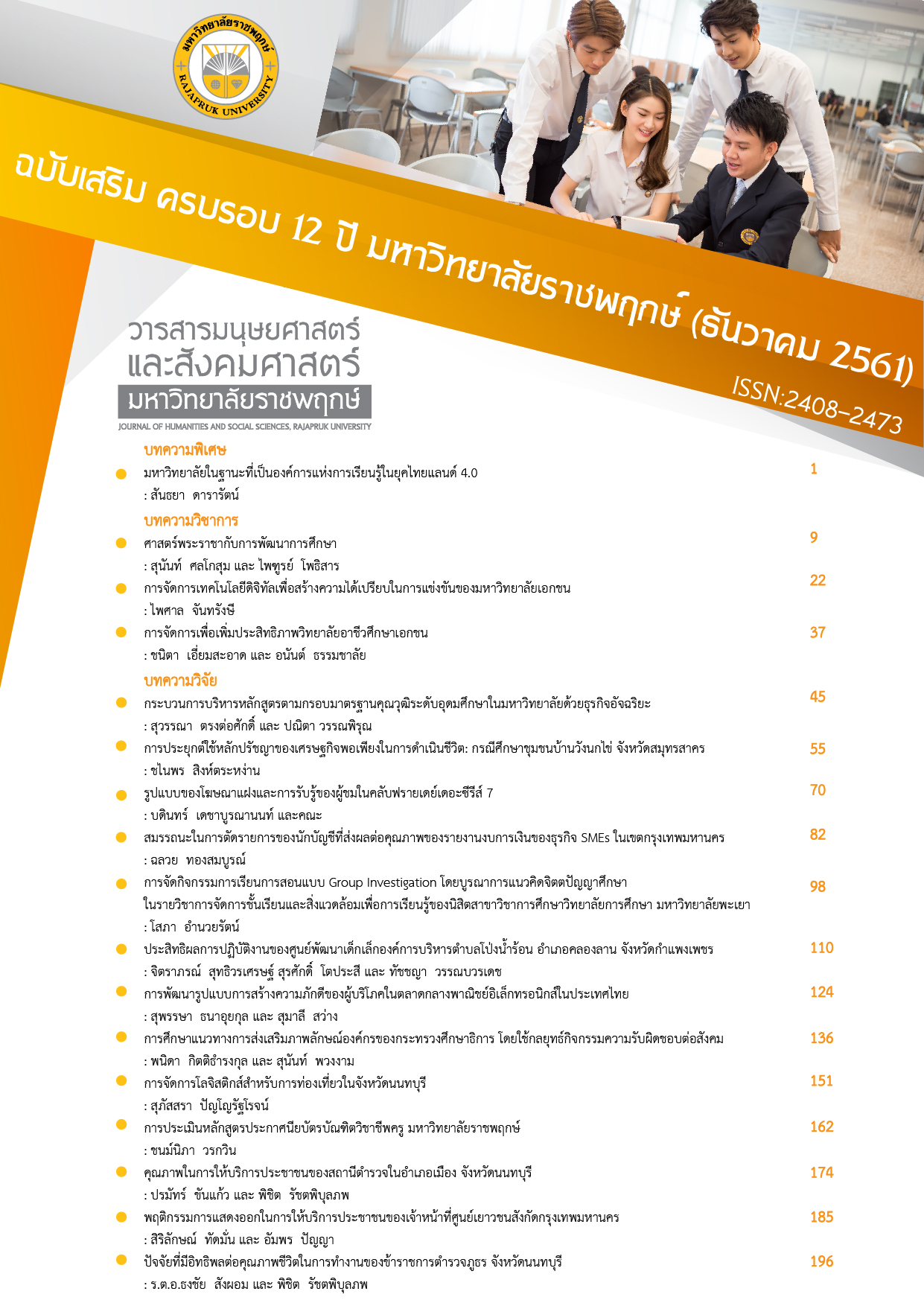The Application of the Principles of Sufficiency Economy Philosophy for Living: A Case Study of Ban Wang Nokhai Community, Samut Sakhon
Main Article Content
Abstract
The objectives of this research were to; 1) study the application levels of the principles of sufficiency economy philosophy for living by using a case of Ban Wang Nokhai community, Samut Sakhon province; 2) compare the application levels of the principles of sufficiency economy philosophy based on the classification of individual traits; and 3) investigate life styles of the community on sufficiency economy philosophy. This mixed design research employed a questionnaire and an interviews as research tools. For a quantitative research method, the data were collected from 119 households and analyzed by using a statistical package program to determine frequency, percentage, mean, standard deviation, F-test, and paired variables by Scheffé method. For a qualitative research method, an in-depth interview was administered to 30 prototype households.
The research results revealed as followed;
- Overall, the application of the sufficiency economy philosophy for living in the community exhibited a high mean level, while the moderation showed the highest mean. On separate domains, the question on how to brainstorm and applied the sufficiency economy philosophy to the community demonstrated the highest mean among questions in this group, while the next lower levels concerned virtuousness, knowledge, reasonableness, and self-immunity. In virtuousness, the question on a good role model of the community in sufficiency economy application showed the highest mean among questions in this group. The question on the support of new knowledge to the application of sufficiency economy in the community had the highest mean among questions in this group. In reasonableness, the question on an improvement of the application of the sufficiency economy relevant to the context of the community exhibited the highest mean among questions in this group. Finally, in self-immunity, the least level mean, the question on risk management planning of the community reported the highest mean among questions in this group. The findings of the qualitative research method showed that the prototype households employed the Civil Society Forum to formulate paths of the community development and to brainstorm feasibility of activities for the moderation of living.
- The results of the analysis on difference of individual traits with the application levels of sufficiency economy revealed that the sample groups with different sex, different occupations, different educational levels, different ages, different incomes, different marital status, different awareness of sufficiency economy, and different sources of information awareness had no significance level in the application of the sufficiency economy at the .05 level, while the sample group who resided out of the community had a significance level in the application of the sufficiency economy at the .05 level.
- The findings from life styles relevant to the application of the sufficiency economy in the community showed that the village had established the financial bureau for loaning and funding supports in careers and in case of emergency, as well as a solution to the informal debt.
Article Details
References
ชัยวัฒน์ วิบูลย์สวัสดิ์ และคณะ. (2546). กรอบแนวคิดทางทฤษฎีเศรษฐศาสตร์ปรัชญาของเศรษฐกิจพอเพียง. กรุงเทพฯ: สำนักงานคณะกรรมการพัฒนาการเศรษฐกิจและสังคมแห่งชาติ.
นภาพรรณ วงค์มณี. (2553). การนำแนวทางปฏิบัติตามปรัชญาเศรษฐกิจพอเพียงไปใช้ในการดำเนินชีวิตของประชาชน: กรณีศึกษา ชุมชนทรายทอง ตำบลเจริญเมือง อำเภอพาน จังหวัดเชียงราย. การค้นคว้าอิสระศิลปศาสตรมหาบัณฑิต สาขาการจัดการภาครัฐและเอกชน คณะศิลปศาสตร์ มหาวิทยาลัยศิลปากร.
ไพศาล เนาวะวาทอง. (2551). การจัดการชุมชนเศรษฐกิจพอเพียงกรณีศึกษา: หมูบานคําปลาหลายตําบลบ้านดง อําเภออุบลรัตน์ จังหวัดขอนแกน. สารนิพนธ์วิทยาศาสตรมหาบัณฑิต สาขาการจัดการสิ่งแวดล้อม คณะพัฒนาสังคมและสิ่งแวดล้อม สถาบันบัณฑิตพัฒน
บริหารศาสตร์.
รังสรรค์ อินทน์จันทน์ . (2558). การประยุกต์ใช้แนวคิดปรัชญาของเศรษฐกิจพอเพียง ในการบริหารจัดการกองทุนหมู่บ้านต้นแบบของจังหวัดสมุทรสาคร. นครปฐม: มหาวิทยาลัย
ราชภัฏนครปฐม.
สมบัติ กุสุมาวลี. (2551). หลักปรัชญาของเศรษฐกิจพอเพียงกับการพัฒนาองค์การ. วารสารพัฒนบริหารศาสตร์, 48(1): 86 - 90.
สายสมร สังข์เมฆ. (2559). การจัดทำบัญชีครัวเรือนของประชาชนในชุมชนเกาะยาวใหญ่จังหวัดพังงา. วารสารมนุษย์ศาสตร์และสังคมศาสตร์มหาวิทยาลัยราชพฤกษ์, 1(3): 26 - 35.
สำนักงานคณะกรรมการพัฒนาการเศรษฐกิจและสังคมแห่งชาติ. (2550). การสร้างขบวนการขับเคลื่อนปรัชญาเศรษฐกิจพอเพียง. กรุงเทพฯ: สำนักนายกรัฐมนตรี.
สำนักงานคณะกรรมการพัฒนาเศรษฐกิจและสังคมแห่งชาติ. (2554). แผนพัฒนาเศรษฐกิจและสังคมแห่งชาติ ฉบับที่ 11 (พ.ศ. 2555 - 2559). กรุงเทพฯ: สำนักนายกรัฐมนตรี.
สำนักงานส่งเสริมการศึกษานอกระบบและการศึกษาตามอัธยาศัย. (2551). หนังสือเรียนสาระทักษะการดำเนินชีวิต รายวิชา เศรษฐกิจพอเพียง (ทช31001) ระดับมัธยมศึกษาตอนปลาย. กรุงเทพฯ: สำนักงานปลัดกระทรวงศึกษาธิการ.
สุเมธ ตันติเวชกุล. (2543). เศรษฐกิจพอเพียงตามแนวพระราชดำริในใต้เบื้องพระยุคลบาท.
พิมพ์ครั้งที่ 6. กรุงเทพฯ: มติชน.
อวยพร สงแก้ว. (2555). ความสำเร็จของการนำนโยบายเศรษฐกิจพอเพียงไปปฏิบัติในระดับพื้นที่ของครอบครัวพัฒนา อำเภอบ้านแพ้ว จังหวัดสมุทรสาคร. การค้นคว้าอิสระ
ศิลปศาสตรมหาบัณฑิต สาขารัฐศาสตร์ คณะบัณฑิตวิทยาลัย มหาวิทยาลัยเกษตรศาสตร์, กรุงเทพฯ.
Community Development Department. (2009). A Guide to the Project Village sufficiency economy model. Bangkok: Suphatchanin Printing Group. (in Thai)
Inchan, R. (2015). The application of sufficiency economy philosophy Concepton management of village and urfan commumity fundmodelin Samutsakhon Province. Nakhon Pathom: Nakhon Pathom Rajabhat University. (in Thai)
Kusumavhree, S. (2008). Philosophy of Sufficiency Economy and Development Organization. NIDA Development Journal, 48(1): 86 - 90. (in Thai)
Naowavathong, P. (2008). Community in Management Sufficiency Economy: A Case Study of Kham Pla Lai Village, Tambol Ban Dong, Amphur Ubonrat, Khon Kaen Province. Master of Science Thesis Environmental management branch Faculty of Social and Environmental Development National Institute of Development Administration. (in Thai)
Office of the National Economic and Social Development Board. (2007). The build process-driven philosophy. Bangkok: Prime Minister's Office. (in Thai)
Office of the National Economic and Social Development Board. (2011). National Economic and Social Development Plan No. 11 (2012 - 2016). Bangkok: Prime Minister's Office.
Office of the Non-Formal and Informal Education. (2008). The living skills course textbook material sufficiency (NTC 31001) high school. Bangkok: Office of the Secretary of Education. (in Thai)
Songkaew, O (2012). The success of economic policy to practice in the area of family development. Autonomous district Samut Sakhon. Independent Arts Political Science Faculty of Graduate Studies Kasetsart University, Bangkok. (in Thai)
Sungmake, S. (2016). Household Accounting Practices of people in Kon Yao Yai, Phang Nga Province. Jourmal of Humanities and Social Sciences, Rajapruk University, 1(3): 26 - 35. (in Thai)
Tantivejakul,S (2001). Just works in the background at the faces. 6th ed. New York: Eng. (in Thai)
Wibulswasdi, C. et al. (2003). The framework of economic theory, the philosophy of sufficiency economy. Bangkok: Office of the National Economic and Social Development Board. (in Thai)
Wongmanee, N. (2010). An Introduction of sufficiency economy philosophy as a Practice fof Living a case study of Saithong Community, Tambon Jaroenmueang, Amphoe Phan, Chamgwat Chiang Rai. Independent Study Submitted Master of Arts Program of Public and Private Management Graduate School Silpakorn University. (in Thai)


